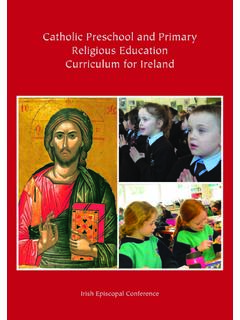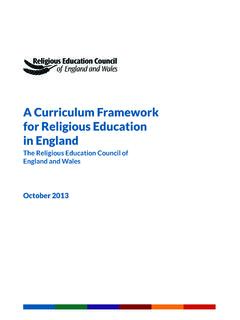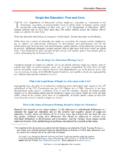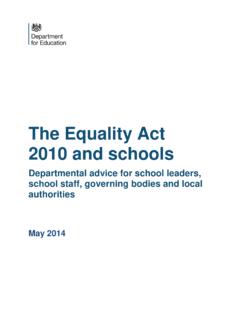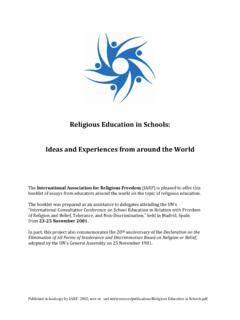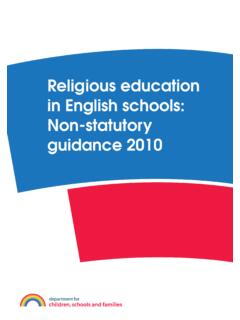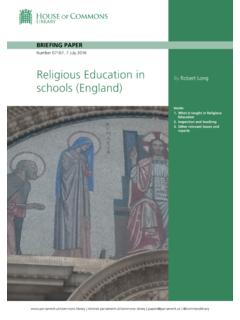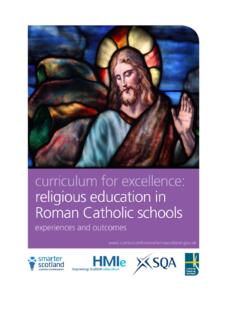Transcription of Religious Education Curriculum Directory (3-19)
1 Religious Education Curriculum Directory (3-19)for Catholic Schools and Colleges in England and WalesCatholic Bishops Conference of England and WalesDepartment of Catholic Education and FormationReligious EducationCurriculum Directoryfor Catholic Schools and Colleges in England and WalesFirst published in Great Britain 2012 Published by:The Department of Catholic Education and Formation of the Catholic Bishops Con-ference of England and Wales, 39 Eccleston Square, London SW1V 1 BXCover illustration:The Sermon on the Mount, Bl John of Fiesole (Fra Angelico), Convento di San Marco, Flo-renceThe Religious Education Curriculum Directory is licensed under a Creative Commons Attribution-NonCommercial-ShareAlike UK: England & Wales which was from the beginning,which we have heard, which we have seen with our eyes, which we have looked at andour hands have touched this we proclaimconcerning the Word of life appeared.
2 We have seen it and testify toit, and we proclaim to you the eternal life, whichwas with the Father and has appeared to proclaim to you what we have seen and heard,so that you also may have fellowship with our fellowship is with the Father and withhis Son, Jesus John 1:1-3vivAbbreviationsCCC Catholic Church, Catechism of the Catholic Church, 1993 CCCC Catholic Church, Compendium of the Catechism of the Catholic Church, 2005 CIC Catholic Church,Code of Canon Law: New revised English translation (Codex Iuris Canonici), 1983 CSTTMS acred Congregation for Catholic Education , The Catholic school on the Threshold of the Third Millennium, 1997CT Pope John Paul II, On Catechesis in Our Time (Catechesi Tradendae), 1979DV Vatican Council II, Dogmatic Constitution on Divine Revelation (Dei Verbum), 1965FC Pope John Paul II, On the Family (Familiaris Consortio), 1981 GDC Congregation for the Clergy, General Directory for Catechesis, 1997 GSVatican Council II, Pastoral Constitution on the Church in theModern World(Gaudium et Spes), 1965LG Vatican Council II, Dogmatic Constitution on the Church (Lumen Gentium)
3 , 1964 NAVatican Council II, Declaration on the Relation of the Church to Non-Christian Religions(Nostra Aetate), 1965 RCIA ICEL, Rite of Christian Initiation for Adults, 1985 SCVatican Council II, Constitution on the Sacred Liturgy (Sacrosanctum Concilium), 1963 URVatican Council II. Decree on Ecumenism (Unitatis Redintegratio), 1964 Contents Preface.. viiPART ONE: INTRODUCTION .. 1 The Context of Religious Education .. 3 The Religious Educator.. 5 PART TWO: APPLICATION OF GENERAL PRINCIPLES .. 6 The aims of Religious Education .. 6 Methodology.. 7 Summary .. 8 Attainment Levels .. 9P Scales.. 9 PART THREE: AREAS OF STUDY.. 10 Area of Study One: Revelation.. 13 Area of Study Two: Church .. 24 Area of Study Three: Celebration.
4 32 Area of Study Four: Life in Christ .. 41 Overview of the Bible .. 50 PART FOUR: CONTENT ACCORDING TO AGE GROUPS.. 53 Age group statement notes .. 53 Provision of Under Fives (Nursery) .. 53 Overview: Pupils 3-5 .. 54 Overview: Pupils 5-7 .. 55 Overview: Pupils 7-11 .. 57 Overview: Pupils 11-14 .. 59 Overview: Pupils 14-19 .. 61 APPENDICESI. Levels of Attainment .. 63II. P Levels .. 68 III. Catechetical Formulas.. 69IV. Bibliography .. 71 References.. 73viviiReligious Education Curriculum DirectoryPrefaceIn his goodness and wisdom God chose to reveal himself and to make known to us the hidden pur-pose of his will by which through Christ, the Word made flesh, man might in the Holy Spirit haveaccess to the Father and come to share in the divine nature.
5 (Dei Verbum 2)Withthese words, the Fathers of the Second Vatican Ecumenical Council describe the rea-son why God revealed himself: the Word was made flesh so that we may become Christ, the fullness and mediator of Revelation, the deepest truth about God and hu-manity has been made known to us. Handed on in Scripture and Tradition, and interpreted by theMagisterium, this Deposit of Faith is a most precious gift, enabling us to know, understand and liveour this year in which we commemorate the fiftieth anniversary of the opening of the Second VaticanCouncil in 1962, and the twentieth anniversary of the promulgation of the Catechism of the CatholicChurch in 1992, our Holy Father Pope Benedict XVI has asked us to celebrate a Year of Faith, whichhe has described as a summons to an authentic and renewed conversion to the Lord, the one Saviourof the world (Porta fidei 6).
6 We do not create our own faith, but are baptised into the faith of theChurch; in her teaching, worship and life, the Church transmits all that she is, and thereby calls usinto a deeper relationship with Christ so that we may live our baptismal vocation to be alive to Godin Christ Jesus (Rom 6:11).I hope and pray that this new edition of the Religious Education Curriculum Directory will help us to dothis by continuing to place Religious Education at the very heart of the Curriculum of our schools,where it rightly belongs. It will help parents, priests and teachers to hand on the Deposit of Faith inits fullness to a new generation of young people so that they may come to understand the richnessof the Catholic faith, and thereby be drawn into a deeper communion with Christ in his of Pentecost, 2012Rt Rev Malcolm McMahon OPBishop of NottinghamChairman of the Catholic Education Service1 Catholic Bishops Conference of England and Wales Department of Catholic Education and FormationPart I IntroductionThepurpose of this new edition of the Religious Education Curriculum Directory (3-19)is to provideguidance for the Religious Education classroom Curriculum in Catholic schools1.
7 Followingthe publication of the Catechism of the Catholic Church(1992), the Bishops of England and Walespublished the Religious Education Curriculum Directory for Catholic Schools (1996) to ensure that teachingand learning in our schools truly reflected the vision and breadth of the teaching of the Church out-lined in the Catechism. This revised Directory is published so that Religious educators can continueto meet the needs of the pupils of our the context of Religious Education has changed significantly over the last fifteen years inEngland and Wales, the teaching of the Church is to be proclaimed faithfully in season and out ofseason2and is the key to human happiness and social prospering. The contemporary focus on themarket economy and personal autonomy creates a more hostile environment in which to presentthe teaching of the Church.
8 The challenges for educators are Britain, the landscape of primary and secondary Education is changing rapidly. The ways in whichChurch and State cooperate in the task of educational provision are having to be reshaped and thisis taking place in the context of increasingly vociferous arguments from those opposed to right ofparents to choose those means and institutionss which can best promote the Catholic Education oftheir children. The Catholic community is continually challenged to explain and justify Catholicschools even though those schools are frequently popular and oversubscribed because parentsrecognise, explicitly or not, that they deliver an excellent Education of the whole note in particular some current trends which affect the teaching of Religious Education :rapid developments in communication and information technology that have led to a web- based proliferation of competing sources of authority ;a further privatisation of morality and a focus on personal choice rooted in feelings has in- creased the domination of the dictatorship of relativism 3in moral reasoning.
9 The practice of selective adherence to the teachings of the Church and growing suspicion of the sources of any authority;new challenges to justice and peace, the threat of global terrorism; the influence of the New Atheism and the rejection of the supernatural; the widespread yet fallacious view that science and faith are opposed to one another; the rich diversity of Religious practice found in modern Britain including the growth of Islam; the changing Religious and cultural profile of pupils and teachers in Catholic schools. In recent years, a number of teaching documents of the Church have further explored the distinctivenature of the Catholic school and have articulated more deeply the underlying philosophy ofCatholic Education .
10 We have also grown in our understanding of the needs of children with disabil-ities and special needs and this is reflected in this Education Curriculum DirectorySome key features of this revised Curriculum DirectoryMore detailed references from the Catechism(CCC) and other sources have been provided for each section within an area of are encouraged to make use of the catechetical formulas found in the Compendium of the Catechism of the Catholic Church (CCCC).Much of the guidance given in Levels of Attainmentin Religious Education in Catholic Schools and Collegeshas been first section of Area of Study Oneis now called Knowing and Loving God, recognising that all knowledge of God is dependent upon God s self-revelation in section dealing with Holy Scripture has been significantly elaborated in terms of detail provided, addressing a concern that pupils are not being given a sufficient grounding in is a renewed emphasis upon Catholic Social Teaching, the Catholic understanding of Virtue, and Theology of the Body.

